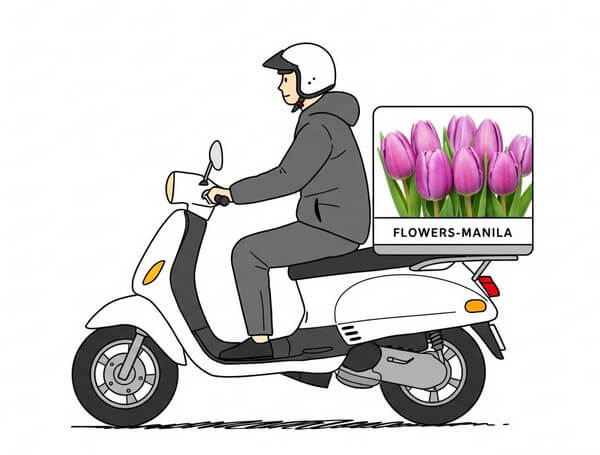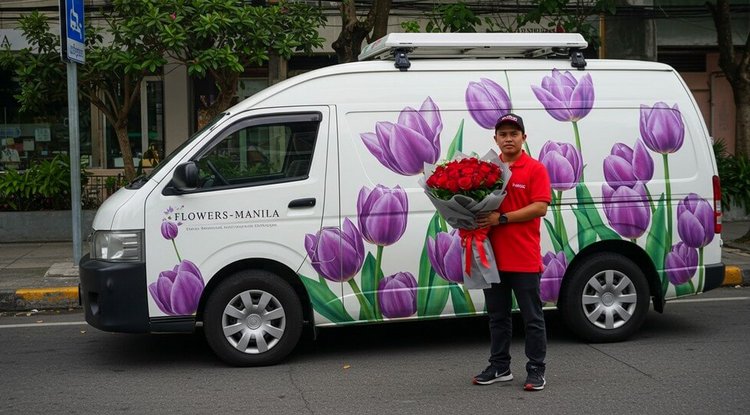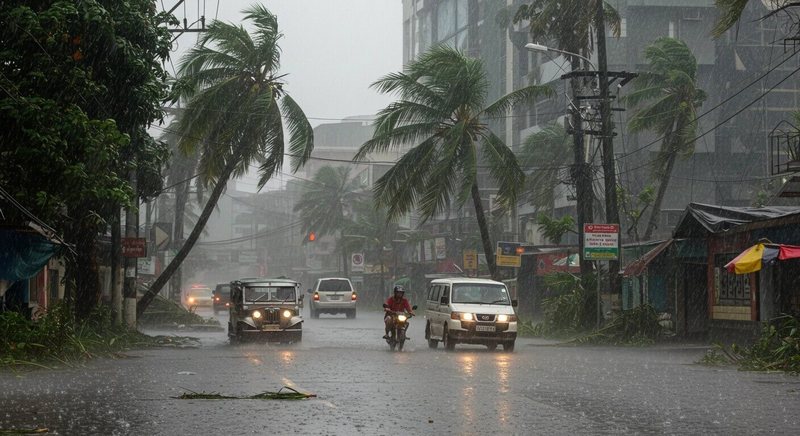
Flower delivery in Manila requires both passion and logistics — it’s not just about sending blooms, but ensuring they arrive fresh, beautifully arranged, and at just the right moment. In Metro Manila, the traffic, the spread of cities, and weather factors all pose challenges for timely delivery. Yet, with proper planning, a local florist can manage to delight recipients across the region. At Flowers-Manila, we understand these complexities and strive to offer efficient, reliable service. Below, we explain how flower delivery works in Manila, the challenges we face, and how we handle them to give your gift maximum impact.
1. The Geography and Scale of Flower Delivery in Metro Manila
When people say “Manila,” many times they refer not just to the city proper, but to Metro Manila (the National Capital Region, NCR) — a conurbation of 16 highly urbanized cities and one municipality (the City of Manila plus Quezon City, Makati, Pasig, Pasay, Caloocan, Valenzuela, Marikina, Muntinlupa, Navotas, Paranaque, San Juan, Malabon, Las Piñas, Mandaluyong, Taguig, and one municipality, Pateros). That region covers well over 600 km² and holds millions of residents.
Because of that spread, delivering flowers is not as simple as “click and go.” After an order is placed, the florist must design or assemble the bouquet (which may take time), pick suitable flower stems, condition them, and coordinate with a courier. Then comes the challenge of navigating traffic, road conditions, and city boundaries. In practice, same-day delivery is feasible within certain zones, but for more distant cities or heavy traffic times, it may take longer or require pre-scheduled delivery. Pre-orders (placing the order some hours or a day ahead) help us plan routes and ensure timely arrival even amid congestion.

2. Flower Delivery cost to Each City in Metro Manila
Since our shop is located near the Dangwa Flower Market — a central hub for fresh flower supply — we have easier access to sourcing and dispatching. Below are approximate routes and special considerations for major NCR cities.
Manila
Postal codes: 1000–1018
Distance from Dangwa: ~1–4 km
Manila is the historic and cultural heart of the Philippines, home to landmarks such as Intramuros, Rizal Park, Binondo (the world’s oldest Chinatown), and the University Belt. The city mixes busy commercial districts, heritage neighborhoods, government offices, and tourist areas, creating varied traffic patterns and occasional street closures. Narrow streets, market districts like Divisoria, and frequent events mean deliveries often require careful timing and coordination with building staff or market vendors. Because many addresses are in older barangays with tight lanes, our couriers sometimes use motorcycles for last-mile delivery to ensure timely arrival. Currently, the cost of flower delivery to Manila (Manila) is 0 Philippine pesos.
Makati
Postal codes: 1200–1235
Distance from Flowers-Manila: ~8–10 km
Makati is the financial and business hub of Metro Manila, with many office towers, corporate headquarters, shopping malls, and upscale condominiums. Traffic is heavy, especially during rush hours, and delivery may require lobby coordination in high-rise buildings. Because many recipients live in gated or high-rise complexes, couriers may need to navigate security procedures or elevator schedules. Currently, the cost of flower delivery to Makati (Manila) is 0 Philippine pesos.
Quezon City
Postal codes: 1008, 1015, 1100-1113
Distance from Flowers-Manila: ~6–12 km
Quezon City is one of the largest and most populous cities in Metro Manila, home to universities, commercial strips, residential subdivisions, and entertainment districts like Quezon Memorial Circle, Katipunan, or Eastwood. Many roads are major thoroughfares (Commonwealth, EDSA, C5) and are prone to congestion. Some neighborhoods are gated or have restricted access, so delivery may require advance notice or coordination. Currently, the cost of flower delivery to Quezon City (Manila) is 0 Philippine pesos.
Pasig
Postal code: 1600-1622
Distance from Flowers-Manila:~9–14 km
Pasig contains both residential zones and busy business districts like Ortigas Center. Roads near malls, office towers, and commercial centers tend to be congested during peak hours. Interior barangays may have narrower streets, requiring couriers to maneuver carefully. High-rise buildings and gated communities in Pasig sometimes enforce strict delivery windows or reception protocols. Currently, the cost of flower delivery to Pasig (Manila) is 0 Philippine pesos.
Pasay
Postal codes: 1004, 1300–1309, 1709
Distance from Flowers-Manila: ~10–13 km
Pasay houses significant commercial landmarks, the airport area, hotels, and shopping malls like Mall of Asia. Major roads like Roxas Boulevard, EDSA, and coastal routes often see heavy traffic and congestion. Hotels and large complexes may require coordination with receptions or security. Some event and entertainment areas in Pasay can generate variable traffic flows, especially during weekends or shows. Currently, the cost of flower delivery to Pasay (Manila) is 0 Philippine pesos.
Paranaque
Postal code: 1700-1720
Distance from Flowers-Manila: ~12–16 km
Paranaque is largely residential with many subdivisions, retail zones, and mixed-use neighborhoods. Some roads are narrow, especially within subdivisions, which may slow down couriers. Gated communities or villages often require security clearance, guard coordination, or schedule constraints. Because it is farther from central Dangwa, delivery windows may be tighter especially during peak traffic. Currently, the cost of flower delivery to Paranaque (Manila) is 0 Philippine pesos.
Caloocan
Postal codes: 1400–1428
Distance from Flowers-Manila: ~8–15 km
Caloocan is a heavily urbanized city with dense residential areas and mixed commercial zones. Many barangays are old, with narrower roads and heavy local traffic. Access to inner streets may require navigating smaller lanes or side roads. During peak hours, main arteries like EDSA, Rizal Avenue, and M. Dela Cruz may become bottlenecks. Currently, the cost of flower delivery to Caloocan (Manila) is 0 Philippine pesos.
Valenzuela
Postal codes: 1440–1447
Distance from Flowers-Manila: ~12–18 km
Valenzuela includes residential districts, industrial zones, and factory areas. Some parts lie on the northern edge of Metro Manila and depend on major bridges or connectors, which are vulnerable to congestion. In industrial zones, heavy vehicle traffic or delivery truck restrictions may slow travel. Rural or less developed barangays can have narrower roads or less direct access. Currently, the cost of flower delivery to Valenzuela (Manila) is 0 Philippine pesos.

Las Piñas
Postal codes: 1700, 1740–1752
Distance from Flowers-Manila: ~15–20 km
Las Piñas is mostly residential, with many subdivisions and mixed housing. Some areas are farther from main roads and require travel along local streets. Gated communities and subdivisions often limit access or have restricted delivery windows. Because of coastal proximity, some low-lying areas may face flooding during heavy rain. Currently, the cost of flower delivery to Las Piñas (Manila) is 0 Philippine pesos.
Malabon
Postal codes: 1409–1480
Distance from Flowers-Manila: ~9–15 km
Malabon is an older, compact city with dense neighborhoods and narrower roads in many barangays. Some areas are flood-prone and may be less accessible during heavy rain or high tide periods. Local traffic patterns can vary; some streets are less maintained or more congested. Couriers must often navigate tight roads, small alleys, and limited parking. Currently, the cost of flower delivery to Malabon (Manila) is 0 Philippine pesos.
Mandaluyong
Postal codes: 1550-1556
Distance from Flowers-Manila: ~7–12 km
Mandaluyong blends residential, commercial, and retail zones. It is centrally located, so access is often easier relative to remote cities. But landmarks like EDSA, Shaw Boulevard, and Ortigas corridors see heavy congestion. Some areas have flyovers, underpasses, or elevated walkways that complicate routes. Condo lobbies and high-rise buildings may impose delivery rules or time windows. Currently, the cost of flower delivery to Mandaluyong (Manila) is 0 Philippine pesos.
Marikina
Postal codes: 1800-1811
Distance from Flowers-Manila: ~12–18 km
Marikina is located to the east and is known for being a more residential, calmer city with hills and rivers nearby. Some barangays are in valleys or higher elevations, which may affect route choice. Many roads are narrower and local, so couriers need careful navigation. Proximity to rivers means some areas are susceptible to flooding in heavy rains. Currently, the cost of flower delivery to Marikina (Manila) is 0 Philippine pesos.
Muntinlupa
Postal codes: 1770–1781
Distance from Flowers-Manila: ~18–22 km
Muntinlupa is a city in the southern end of Metro Manila with growing residential and commercial zones like Alabang, Filinvest, and villages further out. Some barangays are more remote and require traversing major roads or expressways. Traffic on SLEX and adjacent roads often affects arrival times. Gated subdivisions and security procedures may further impact drop-off timing. Currently, the cost of flower delivery to Muntinlupa (Manila) is 0 Philippine pesos.
Navotas
Postal code: 1430, 1485
Distance from Flowers-Manila: ~10–15 km
Navotas is a coastal city with areas of fishing communities, narrow alleys, and small roads particularly near estuaries. Some barangays have limited access, especially in densely populated zones. Delivering through coastal areas can involve road constraints or bridges. Couriers may need to plan carefully to avoid congestion on arterial routes. Currently, the cost of flower delivery to Navotas (Manila) is 0 Philippine pesos.
San Juan
Postal codes: 1500–1509
Distance from Flowers-Manila: ~5–10 km
San Juan is small and centrally located; many parts are close to central Manila and relatively accessible. Yet, traffic along main roads (e.g. E. Rodriguez, P. Guevarra, Shaw) can still slow delivery. Residential streets may have tight curves or limited parking. High-rise residential complexes may need lobby coordination or timing windows. Currently, the cost of flower delivery to San Juan (Manila) is 0 Philippine pesos.
Taguig
Postal codes: 1208, 1630–1639
Distance from Flowers-Manila:~10–18 km
Taguig includes vibrant business districts (like BGC), upscale residential towers, and large subdivisions. Access to some condominium towers involves drop-off regulations, security checks, or elevator scheduling. Roads like C5, 32nd St, and major connectors may be congested. Some subdivisions have limited vehicular access or more remote roads. Currently, the cost of flower delivery to Taguig (Manila) is 0 Philippine pesos.
Pateros (municipality)
Postal codes: 1620–1621
Distance from Flowers-Manila:~9–12 km
Pateros is relatively small and borders Makati and Taguig. It is mostly residential with some commercial strips. Because of its size, delivery is often quicker than in distant cities, but traffic bottlenecks or tight streets may still exist. Some barangays may be less accessible, especially in inner lanes. Currently, the cost of flower delivery to Pateros (Manila) is 0 Philippine pesos.
3. Challenges for Flower Delivery in Metro Manila
Delivering flowers across Metro Manila is never trivial, especially during typhoon season. In the Philippines, the typhoon season generally stretches from June to December, with peak months often from July through September. During these months, tropical cyclones (locally called bagyo) regularly strike or brush by, bringing heavy rains, flooding, strong winds, and hazardous conditions.
On severe typhoon days, it may be dangerous for couriers to go outside. Roads may flood or be blocked, bridges or ramps may be impassable, and vehicular traffic may be suspended. As a result, deliveries might be delayed by several hours or even days. Not only does this affect delivery from our shop to recipients, but also affects the supply line: fresh-cut flowers shipped from wholesale suppliers to our shop or imported stems (from China, Korea, Netherlands, Ecuador, etc.) shipped to local wholesalers may be delayed or held up by weather. Under these extreme conditions, no flower shop in Manila can fully guarantee delivery on the scheduled time; we commit to delivering as soon as safety allows.

Further, Metro Manila lies in the Pacific Ring of Fire, where roughly 90% of all earthquakes occur globally. The region is crisscrossed by active fault lines, so significant tremors may occur. In such cases, safety protocols and road closures may disrupt delivery services. During seismic events, delivery must pause until roads and infrastructure are deemed safe. Under these force majeure conditions, we make every effort to resume deliveries swiftly but cannot promise on-time arrival.
4. Delivering Flowers in Manila in Hot or Rainy Weather
The climate in Metro Manila during both the dry and rainy seasons presents challenges for preserving flower freshness. During hot or humid days, delicate blooms may wilt faster. To counter this, we employ stem protection techniques: before delivery, we mist bouquets with fine water spray to add surface moisture, wrap stems in moisture-retaining wraps, and sometimes wrap the bouquet in insulated covers. Inside our shop, we store flowers in temperature- and humidity-controlled flower refrigerators to prolong life and preserve color.
For flower baskets and boxes, we use water oasis / floral sponges at the base, providing a water reservoir to keep stems hydrated during transit. Recipients only need to add a small amount of water after delivery to maintain freshness. We also plan delivery routes to minimize travel time and avoid exposure under direct sun or heavy rain. Before dispatch, our staff often call or message the recipient to confirm the delivery window and ensure someone is ready (or that there is a safe drop-off spot such as a condo lobby, hotel reception, office front desk, or store). This coordination helps avoid missed deliveries or leaving flowers in unsuitable places.
In rainy conditions, couriers use protective covers or waterproof wrapping to shield bouquets from sudden downpours. For heavy rains or storms, we may delay departure slightly to wait for a lull, while keeping customers informed. Our goal is always to meet the client’s requested schedule, but safety and flower integrity remain priorities.

5. Why Choose Flowers-Manila: Our Advantages
At Flowers-Manila flower shop, we pride ourselves on combining artistry with reliable delivery across the Metro Manila region. Our florists are professionally trained, with years of experience in designing elegant and lasting arrangements. We maintain a large, fresh inventory of blooms from trusted suppliers, so you’ll find options ranging from budget-friendly to premium collections. We welcome custom orders — you can request specific colors, flower types, or design styles, and we will do our best to accommodate.
Because of our proximity to the Dangwa Flower Market, we often secure fresh stems early in the day, enabling us to offer free delivery in several key cities across NCR. For regular customers, we provide loyalty discounts, promos, or priority scheduling. Moreover, our system allows you to place pre-orders to avoid delays and guarantee arrival on your chosen date and time. We strive not only to deliver beautiful bouquets but also to offer flexibility, transparency, and a caring touch — making us a top choice for flower delivery in Manila.
